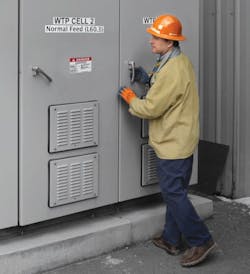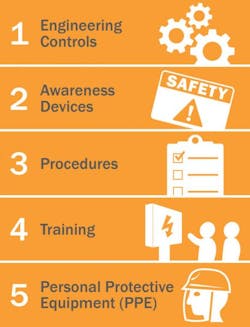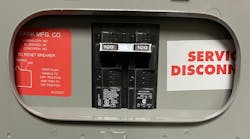The most frequently used standard for workplace electrical safety is NFPA 70E, “Handbook for Electrical Safety in the Workplace.” As noted at the beginning of this standard, in Sec. 110.1(A), employers are required to create an electrical safety program that is intended to provide safe work instructions for a facility, avoiding or mitigating risks that are present. As a result, an effective safety program requires a clear understanding of all risks within the facility.
A systematic approach to identifying and analyzing these risks is a “risk assessment,” which follows a simple, three-step sequence:
1. Identify any hazards.
2. Assess the risks associated with those hazards.
3. Implement controls to limit that risk.
These three short steps may give the impression that risk assessments don’t require much attention, but that’s far from true. Risk assessments are the foundation of any safety program. The NFPA 70E standard includes some recommendations on risk assessments, as well as an optional section that describes the process in greater detail.
Identifying hazards
A hazard is any potential source of injury. For an electrical risk assessment, let’s focus on electrical hazards — situations that could result in electric shock, thermal burns, arc flash burns, or arc blasts.
Electric shocks can be caused by contact or unsafe approach to energized conductors or circuit parts. Any situation involving an exposed conductor has the potential to be a shock hazard. Some of these hazards can be caused by improper installation. That’s why the National Electrical Code (NEC) exists — to ensure that electrical wiring and equipment are installed in a safe way.
One of the more extreme hazards in electrical work is the danger of arc flash. In an informative note, NFPA 70E mentions that “under normal operating conditions, enclosed energized equipment that has been properly installed and maintained is not likely to pose an arc flash hazard.” However, situations where equipment needs to be installed, removed, opened for examination, or repaired cannot be considered “normal operating conditions.”
Additionally, the requirement for proper maintenance doesn’t mean the maintenance work itself isn’t likely to pose an arc flash hazard. In fact, required maintenance work and repairs are the tasks most likely to be involved in an arc flash incident. A National Institute for Occupational Safety and Health (NIOSH) study, “Reducing Non-Contact Electrical Arc Injuries: An Investigation of Behavioral and Organizational Issues,” found that 74% of the arc flash injuries studied had occurred during maintenance, repair, or troubleshooting.
That being said, some equipment is not likely to pose a significant electrical hazard. Class 2 power supplies (which operate at 24V or less and draw less than 100VA), listed low-voltage lighting systems, and similar equipment are considered relatively safe. However, this assumption relies on the equipment being properly installed and maintained — and used according to the manufacturer’s instructions. Misused or poorly maintained equipment, even at low power levels, can pose a serious hazard.
Assessing the risks
Once you have identified each potential source of electrical injury in a given work space, you’re ready to move on to assessing the risks for those hazards. “Risk” refers to a combination of ideas — the severity of an injury and the likelihood of that injury occurring. Informative Annex F of the NFPA 70E standard describes a procedure for breaking down this concept into smaller parts. Start by ranking the severity of the potential injury into one of these categories:
• Fatal or life-altering injury, permanently preventing a return to work.
• Severe injury, requiring hospitalization.
• Reversible harm, requiring professional medical attention.
• Minor injuries, requiring first aid only.
Then, for each task or procedure that could expose an employee to the hazard, rank the likelihood of an injury’s occurrence, using these parameters:
• How often will a worker be exposed — once an hour, once a day, once a month, or once a year?
• When a worker is exposed, how likely is it that the exposure will actually result in a harmful event?
• If a harmful event occurs, how likely is it that the worker will be able to limit or avoid injury?
Combining the severity of a potential injury with the likelihood of the injury occurring will give you an estimate of the total risk for a given task (Fig. 1).
For example, a given piece of equipment may use enough power that a failure would cause extensive burns to an exposed worker. That’s fairly severe. But workers may only need to access that equipment once a year for maintenance, and the design of the equipment may provide a simple and reliable system to ensure that the equipment is powered down before access is possible. In this case, the probability of a worker being harmed is relatively low, so the overall risk is not as high as it could have been.
Another piece of equipment may offer only a minor shock hazard — an injury likely to require only first aid. However, the source of that hazard may be an exposed and unmarked conductor, which offers no indication of its power state, and is located close enough to a workstation that a worker could accidentally contact it very easily. Although the hazard itself is not severe, the overall risk is very high because an injury is practically certain to happen.
When assessing the probability of a harmful event, it’s tempting to assume that your workers are well-informed and are using the equipment correctly. This will result in inconsistent and overly optimistic assessment results, which may lead to a false sense of security. Always try to imagine the worst-case scenario, keeping “Murphy’s Law” in mind — if it can go wrong; it probably will.
Implementing controls
Once you’ve identified hazards and assessed the risks of each, you’ll be able to see where action is needed. The steps that you take to protect workers should follow a hierarchy, so that the most effective approaches are tried first (Fig 2). Many hazards will require more than one protective action to be taken. The NFPA describes this sequence as follows:
1) Engineering controls, such as barriers and redesigned equipment, which can eliminate a hazard entirely or provide physical separation between a hazard and a worker.
2) Awareness devices, such as signs and labels, which ensure that workers and visitors are aware of a hazard before they are exposed to it.
3) Procedures, including written plans and instructions, which give workers specific guidance on performing a given task safely.
4) Training, explaining what to do, what not to do, and the reasons behind those steps, which gives workers a general background of safety that applies to similar situations.
5) Personal protective equipment (PPE), such as gloves and face shields, which offers a last line of defense for workers exposed to a hazard.
The steps to limit risk should always begin with engineering controls because all other approaches ultimately rely on workers not making mistakes. Mistakes are always a possibility. By implementing a control that physically separates workers from a hazard, you make the greatest possible reduction in risk.
Signs and labels offer awareness of a hazard, which helps to limit the kinds of mistakes that result from an uninformed worker doing what they consider safe. Even an untrained worker can read a label, and in a safe workplace that can be enough to prompt the necessary actions.
Specific procedures and general safety training both offer ways to prepare workers beforehand. Setting a procedure lets you and your safety team plan a safe way to do the work; general safety training empowers your workers to make safe decisions on the spot, in unexpected or new situations.
PPE is always the last step. If a dangerous situation has progressed to the point where PPE is protecting a worker, too many things have gone wrong. This isn’t to say PPE is unimportant: Where needed, it’s essential. But never rely on PPE to protect workers unless all other possible controls are in place.
Moving forward
Once controls have been put into place, the process isn’t over. Instead, the steps taken should be reviewed. Has the risk been reduced to acceptable levels? If not, why not, and what else can be done to improve the safety of the situation?
At some point, it will become infeasible or impractical to reduce the risk any further. Has your process reached this point? Is the remaining risk acceptable, or is there a deeper problem at the heart of the situation? You may find that a given work process simply cannot be made safe enough. In these cases, find another work process. Have you missed an important detail? Take advantage of your workers’ expertise and use outside resources, such as compliance assessment services, to review your decision-making process.
Reaching a point of minimized risk isn’t permanent. Over time, equipment degrades, and new technologies arise. Thus, Sec. 130.5 of NFPA 70E requires arc flash risk assessments to be updated whenever your facility has a major modification or renovation, and they must have at least one review every five years.
OSHA requires employers to provide a safe workplace for their employees, and the NFPA offers a standardized approach to make that happen. Keeping your electrical risk assessments current is an ongoing process, but it will ensure that your workers are protected from electrical hazards.
McFadden is a compliance specialist with Graphic Products, Beaverton, Ore. He can be reached at [email protected].






